Syzygium australe is a very well-known bush tucker plant, producing plump little pink edible fruits that have been considered excellent native food for generations. This specific variety of lilly pilly is widely cultivated for its excellent hedging abilities but it can also serve many other functions within your natural spaces.
If you’re looking for an attractive, easy-going tropical tree to add to your collection, this wonderful Lilly Pilly variety may be the perfect pick for you.
More...
Genus: | Syzygium |
|---|---|
Species: | S. australe |
Family: | Myrtaceae |
Common Names: | Creek Lilly Pilly, Brush Cherry, Scrub Cherry |
Location: | Outdoor |
Type: | Tree |
Growth: | 4 to 6 metres tall, 2 to 3 metres wide |
Sun requirements: | Full sun to part shade |
Foliage Colour: | Green |
Flower Colour: | White |
Flowering: | Spring |
Fruit: | Summer |
Maintenance level: | Low |
Poisonous for pets: | Non-toxic to cats and dogs |
Getting to Know Syzygium australe
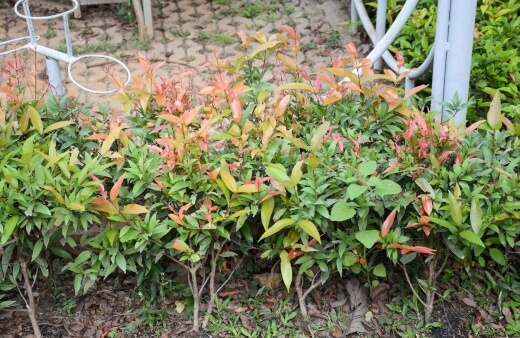
The Acmena genus, commonly referred to as Lilly Pilly, has many different botanical names including Eugenia, Acmena and Syzygium.
The Syzygium australe forms a part of the Myrtaceae family and is a rainforest tree native to eastern Australia where it can be found near the coastal regions of Queensland and New South Wales, thriving in a warm and tropical climate.
Commonly known as Creek Lilly Pilly, Brush Cherry or Scrub Cherry, this native tree is hardy and fast-growing.
Cultivated Syzygium australe trees grow to be around 4 to 6 metres tall and 2 to 3 metres wide with a dense growth habit, lush dark-green foliage and bright new growth that produces beautiful white clustering flowers and edible bright pink fruits.
This Lilly Pilly variety is one of about 60 indigenous to Australia and it is now a very popular native hedge plant and bush tucker Check out our Lilly pilly growing guide overview to find out more Syzygium varieties you might want to grow in your garden.
Brush Cherry Landscaping Applications
This tree can offer both practical and ornamental applications within your landscape. Syzygium australe can grow in the garden or be potted and the beautiful, glossy foliage responds extremely well to pruning, meaning you can control the growth well and get creative with how you use it in your garden.
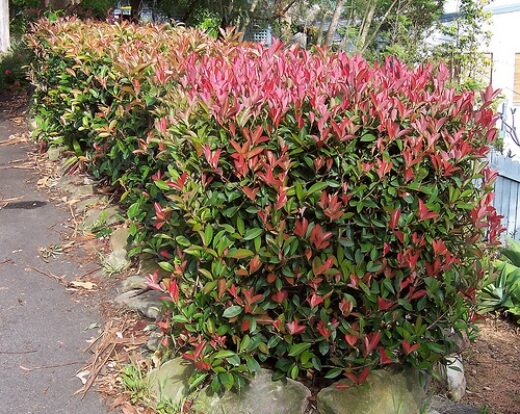
Source: thetutuguru.com.au
This variety of Lilly Pilly can be grown as a shrub-like plant or as a small to a medium sized tree and it features a non-invasive root system.
Here are some popular landscaping positions:
- Feature plant
- Formal hedge
- Great used for medium to large topiary projects
- Screen
- Large container plant
- Perfect for native gardens – attracts local birdlife and plant is an excellent companion for other natives
- General lush garden shrubbery
How to Grow Syzygium australe
This plant can be grown from seed or propagated using cuttings from a healthy parent plant. These trees are suited to establishing themselves in our sometimes-harsher environments and are therefore known to be fast-growing, hardy plants generally. Growing containers should have good drainage.

Growing Creek Lilly Pilly from Seed
Seeds from many varieties of Lilly Pilly are easy to grow but they can be slow to germinate. Seeds can be purchased from local nurseries or collected from fresh, ripened fruits.
- Clean and remove the flesh from the seed and leave it to soak in water overnight
- Prepare your seed tray or containers with a quality potting mix
- Gently push the seed about 2cm deep into the soil
- Place in a warm and humid environment away from too much direct light
- Keep the soil moist but not wet otherwise your seed could rot
Germination can occur in 6 weeks or longer depending on the conditions. Ideal germination temperatures are between 18-26°C. You can sow multiple seeds at once to improve your chances of growing a healthy seedling for use.
Propagation Scrub Cherry Using Cuttings
Cuttings can be easy to strike given the right conditions. Be sure to take your cuttings from a disease-free, thriving donor plant and always use sharp, sterilised tools.
- Take a 10cm long cuttings of new growth that is hardening
- Remove the lower leaves and cut back the top leaves by about half
- Dip the dried stem ends of your cuttings into some rooting hormone and place each cutting in an individual pot or container filled with rich, well-draining soil
- Keep the soil moist but not wet in a warm and humid location
- Cuttings can take several weeks to start developing new growth and establishing themselves in the containers
Planting Lilly Pilly Syzygium australe
Whether planted straight into your garden bed or potted in a container, this plant will thrive and grow best in certain conditions. Locations that receive regular cold winds or frost should be avoided as much as possible when considering where to plant this tree in your landscape. It is recommended to plant in spring to early summer.
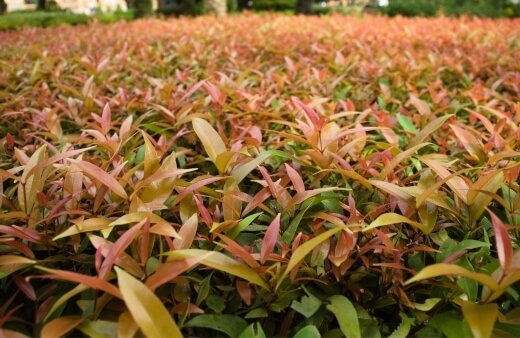
Lilly Pilly Australe Light Requirements
This plant will perform best in a full sun position but it can also grow in partly shaded locations as well. Generally, the more shade the plant receives, the slower the growth and the thinner the foliage.
Best Soil for Syzygium australe
Syzygium australe prefers open and deep soil that has reliable moisture levels across the warmer summer months. Your soil should be rich and well-draining but it can grow in poorer soils.
If you want to give your soil a little boost, you can add and mix some compost or peat moss into your existing soil.
(In the past, our recommendation included peat/sphagnum moss. But, in light of its environmental implications, we've shifted our focus to more sustainable alternatives that provide equally, if not more, favorable results. Read through our comprehensive guide to explore peat moss and its substitutes.)
How to Plant Syzygium australe
- Dig a hole at least twice the size of the root ball
- Gently tease the roots of your plant to remove old soil and then place it into the hole and backfill
- Form a raised ring or doughnut around the base of the tree to help it retain water
- Mulch around the base of the plant and water well
Spacing your plants out correctly is also important so it’s always good to follow the 3:1 rule. For example, if you’re hoping to grow your plant to 2 meters tall, then space roughly 60cm apart. For hedging or screening, it is recommended to plant 50cm to 1m apart.
For container growing, try to make sure the pot is at least twice the size of the root ball. As the tree grows, you will need to transplant it into larger containers to encourage new growth.
Move a single container size up each time and transplant in late winter or early spring to allow the tree to establish itself vigorously over summer.
Caring for Lilly Pilly Australe
Once established, this hardy native can tolerate drought and is slightly frost resistant. For a thriving tropical tree, it is best to follow a healthy care routine, especially if the plant is being used as a formal hedge or feature in the garden.
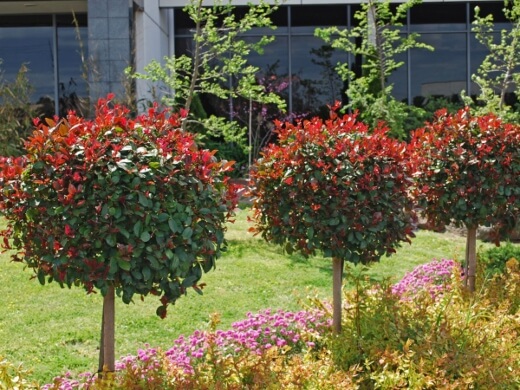
Source: homedesigndirectory.com.au
Watering Needs
These plants love water. Regular watering is especially important while the plant establishes itself and during flowering and fruiting seasons in the warmer months. It is recommended to keep the soil moist but not waterlogged.
What Fertiliser to Use
Fertilise every spring with a native slow-release fertiliser for abundant blooms and fruits. You can also use specialised bush tucker fertilisers available online and at local nurseries.
Pruning Syzygium australe
This plant responds very well to pruning. Prune to keep tidy and to keep your desired shape. It can withstand more aggressive clipping as well. If used as a hedge or screen, pruning regularly is recommended to maintain density.
Be sure to only prune after the flowering season. See our guide for more information on how to prune Australian native plants.
Mulching
Keep your plant well mulched during its development and active growing seasons. Water well before and after mulching. To learn more about mulching, see our full guide for the best types of mulch for the garden.
Clean-Up
Fallen fruits may need to be collected after flowering. If the fruits pose a problem in your location, you can choose to prune off spent flower heads after flowering to prevent fruits from developing.
Syzygium australe Bush Tucker Guide
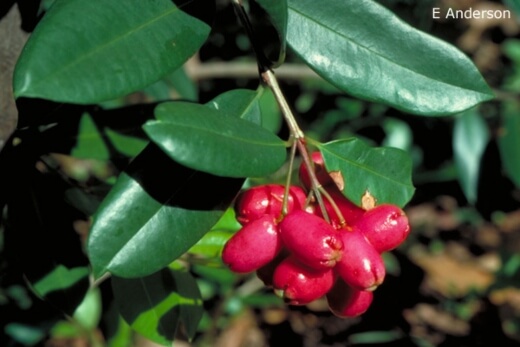
Source: anpsa.org.au
After flowering in summer, the creamy-white powder puff flowers eventually turn to edible candy-pink elongated fruits that offer a crisp texture with a pleasantly sour flavour profile.
These berries, known as riberries, ripen between summer and autumn when they can be eaten fresh, cooked or stored and used as a fruit-based addition to jams, jellies and sauces.
This specific variety of Lilly Pilly is widely cultivated for its particularly tasty fruit. There are also many health benefits to eating these fruits. Native Australians have used the berries of the Lilly Pilly to prevent colds and fight infections for generations.
The berries are known to:
- Be high in Vitamin C.
- Be a great anti-oxidant and boost the immune system.
- Reduce inflammation
- Boost collagen production in the skin.
The berries are quite tart when eaten raw, so they are also often cooked, baked or boiled. Due to the diverse flavour profile these berries offer, they can be used in a large variety of culinary applications.
Bush Tucker Tips
Fruits are normally harvested after flowering from early December through to mid-January and you can simply pluck ready fruits from the branches of your tree, wash and then store or use them.
Ripe fruits will appear pink and plump. To store the berries, refrigerate or freeze them as soon as possible after picking. They will keep in the fridge for up to 3 weeks and the freezer for up to 2 years.
Syzygium australe Hedging & Screening

Source: alpinenurseries.com.au
The Syzygium australe makes for an excellent native hedge plant thanks to the dense foliage that grows to the ground. Lilly Pilly Resilience are generally one of the most cultivated hedge plants in Australia so if you’re looking at establishing a hedge or screen in your landscape, this variety may be a great option.
This plant offers colourful and rich foliage with attractive fruits and flowers that will be frequented by local birdlife. Plant 50cm to 1m metre apart with an average spacing of 75cm between each plant for best hedging and screening results.
Prune regularly to keep tidy. To help you on this task, see our product review and buying guide for the best hedge shears available online.
Also, be sure to check our in-depth guide on the best Australian Native Hedge Plants to help you decide which hedging plant would work best for your garden.
Common Syzygium australe Problems & Diseases
As tough as this hardy native is, the Syzygium australe can be prone to some pest issues in certain regions. Overall, this plant shouldn’t present many problems when growing as long as the conditions are right and it is generally considered a low-maintenance addition to the garden.
Psyllids & Scale Insects
These infestations will cause pimple-like growths that form on the leaves. To treat the plant, you can prune off damaged foliage and apply a horticultural oil or spray. Be sure to collect and dispose of infected foliage.
Syzygium australe Frequently Asked Questions
How fast does Syzygium australe grow?
This tree can grow about 2 metres each year and is generally fast-growing in the right conditions.
Is Syzygium the same as lilly pilly?
The Syzygium varieties are Australian native Lilly Pillies. This variety is a superb hedging and screening plant in most situations.
How long do lilly pilly trees live?
The average lifespan of this tree is approximately 20 years. They also take about 3 to 5 years to fully establish themselves in the garden.

Syzygium australe in Perfect for Your Landscape
This vibrant and luscious Lilly Pilly variety is the perfect pick for those who want to spruce up their gardens with a decorative feature plant, native hedge or large container ornamental.
Boasting bountiful creamy-white puffy blooms and tasty nutritious fruits, Syzygium australe makes for an excellent lively and wild addition to any Australian garden.
Published on April 28, 2022 by Nathan Schwartz
Last Updated on February 26, 2024




